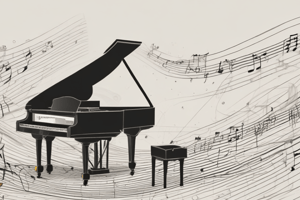Podcast
Questions and Answers
What is one of the primary functions of automation in a doctor's office?
What is one of the primary functions of automation in a doctor's office?
- To provide accurate diagnoses quickly (correct)
- To improve patient interaction
- To replace medical secretaries
- To diagnose diseases without doctors
Dictation and transcription machines are used primarily to assist medical secretaries.
Dictation and transcription machines are used primarily to assist medical secretaries.
True (A)
What are common recording mediums for dictation devices?
What are common recording mediums for dictation devices?
Plastic disc, wax-coated tape, magnetic tape, or wire
The process of producing copies using a wax-coated stencil is called _____ duplicator.
The process of producing copies using a wax-coated stencil is called _____ duplicator.
What additional equipment can enhance the operation of a transcription machine?
What additional equipment can enhance the operation of a transcription machine?
Why is it important for a secretary to be familiar with medical terminology?
Why is it important for a secretary to be familiar with medical terminology?
Flashcards are hidden until you start studying
Study Notes
Automation in the Doctor's Office
- Computers are being used for speedy diagnoses in doctor's offices.
- The use of electronic devices speeds up clinical procedures and makes them more accurate.
- The focus of this section is on business machines that expedite and lighten a medical secretary's work.
Dictation and Transcription Machines
- Doctors use dictation and transcription machines to record letters, reports, and articles.
- These machines can be used in various locations, including the doctor's desk, home, car, and even around the neck.
- Recording devices vary including plastic discs, wax-coated or plastic belts, magnetic tape, and wire.
- The machines come in different sizes: miniature, portable, and standard.
- They can record from 90 minutes to several hours of dictation, depending on their size.
- All machines have a switch for playback and corrections.
- Some machines are used for both recording and transcribing, while others have separate parts for each function.
- Instruction booklets accompany each machine for operation and placement of the recording material.
- Operating a machine can be learned quickly, but practice is required for smooth use.
- Transcription principles are the same for all types of machines and recording devices.
- The machine is placed next to the typewriter and started.
- Headphones or an amplifier help to regulate tone, volume, and speed for the secretary's comfort.
- A foot-pedal switch is useful for starting and reversing the machine.
- An index counter makes it possible to locate specific references quickly and indicate the length of a letter.
- Secretaries should listen carefully for instructions and corrections as the dictator will provide information about the number of copies, setup, paragraphing, and other matters.
- The machine can be reversed to find the correct place if the secretary is interrupted.
- The machine's replay function can be used to review dictation if the secretary does not understand something.
- The secretary's skill in spelling, punctuation, capitalization, and medical terminology impacts transcription efficiency.
- A simple device on the machine erases dictation from tape, wire, and wax records.
- Discs and belts cannot be reused but are often filed for later reference.
Duplicating Methods
- It is sometimes necessary to make copies of documents such as letters, bills, reports, memorandums, and patient histories.
- 8-10 clear carbon copies can be made at one typing using onionskin copy paper and featherweight carbon.
- Special duplicating processes are used for larger quantities of copies, such as 50 or 100.
Stencil Duplicator
- One of the least expensive methods of duplicating.
- Material is typed on a wax-coated stencil.
- The typewriter ribbon is disengaged, allowing the type to cut characters directly onto the stencil.
- Proofreading the stencil as it is typed, preferably every one-half dozen lines, is recommended.
Studying That Suits You
Use AI to generate personalized quizzes and flashcards to suit your learning preferences.




